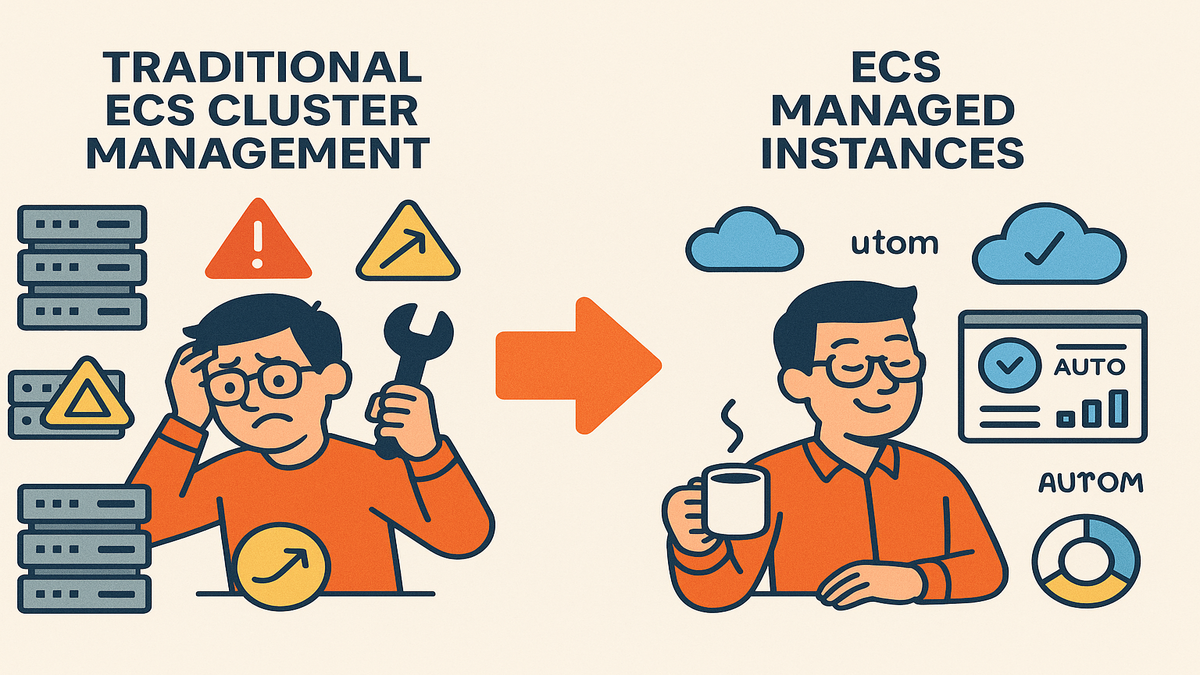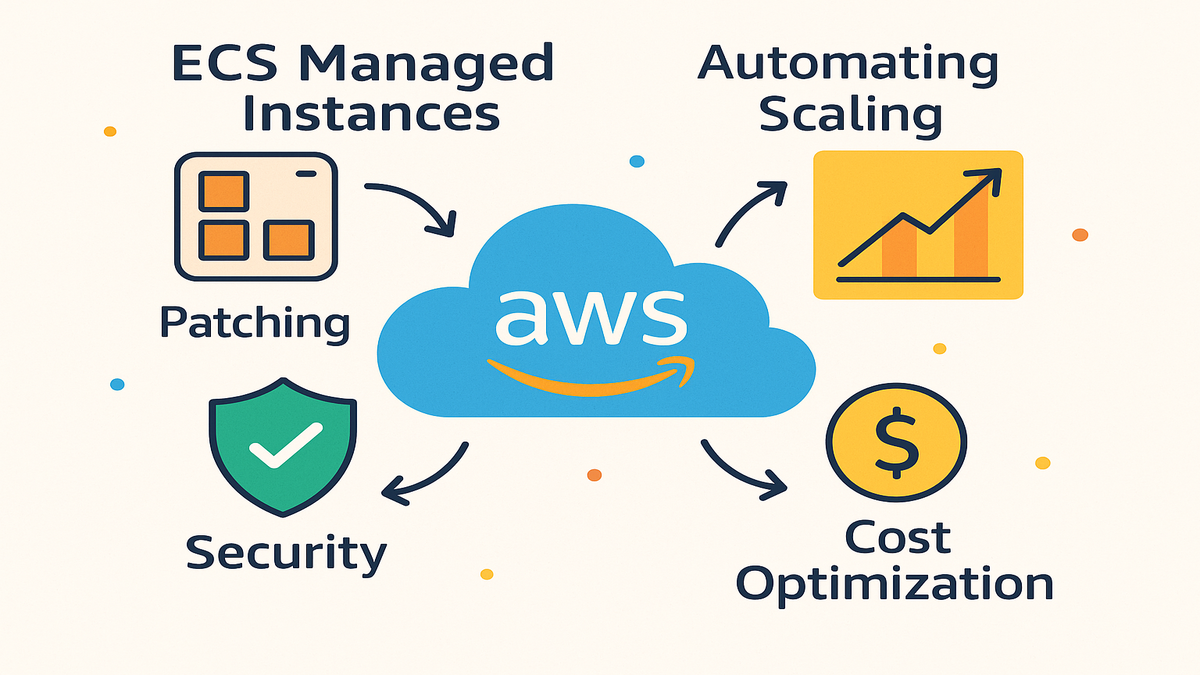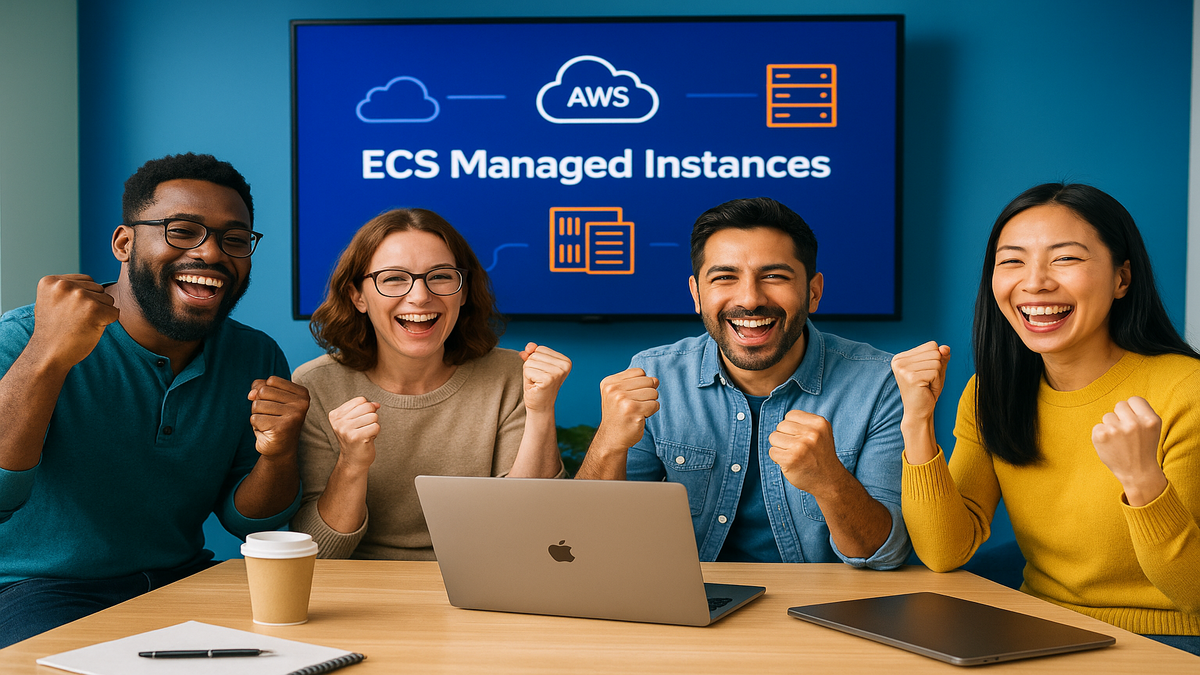
Amazon ECS Managed Instances: Zero Infrastructure, Max Flexibility

You want to spend your time building awesome stuff, right? Not losing sleep over servers. But somehow, here you are, patching OS bugs at midnight. Or sweating over a crazy-high cloud bill like your heart’s about to spike. Sound way too real?
Plot twist: AWS just dropped Amazon ECS Managed Instances. Honestly, this is like getting a self-driving car for your app’s infrastructure. Now, AWS is telling you, "Hey, focus on building. We’ll handle the dirty work behind the scenes."
You still get all the stuff you love about EC2: flexibility, custom CPUs, GPU muscle, reserved plans, tough compliance. But you never have to log into a server or wake up at 2 a.m. for a security fix.
Even better, AWS does all the brain work, too. They spin up resources, cut your costs, scale everything up and down, and keep things patched and safe. So now you can work as fast as a startup, with power to spare, and still enjoy some peace and quiet. No more putting out fires, just making progress.
Key Takeaways:
- Amazon ECS Managed Instances = no more infra babysitting, same EC2 muscle
- AWS handles scaling, patching, cost tuning automatically
- Works with any EC2 type—GPUs, custom CPUs, reserved deals
- Lower bills thanks to AWS's smart placement engine
- Baked-in AWS support for monitoring, security, and compliance

Why AWS Shook Up Containers
Let’s be honest. Running containers at scale used to mean fighting YAML, adjusting clusters, and always worrying if you picked the right EC2. Dev teams moved slow, patching hosts, chasing audits, tweaking resources—not fun.
ECS Managed Instances flips that. AWS wipes all the painful stuff off your list: picking instances, patching, scaling, fixing cost leaks—they handle all of it. It’s not just easier. It’s AWS proving you can get strong, safe, and reliable infrastructure while focusing on building, not maintaining.
The Old Way
If you’ve run ECS clusters "the usual way," you know the pain. You pick your servers, install and patch the OS, set up scaling, balance spot vs reserved vs on-demand, and cross your fingers you didn’t leave a security hole or blow the budget.
Get it right, nobody notices. Get it wrong, you’re fighting downtime or stuck changing hardware for weeks. Ask any SRE—worst late-night calls almost always come from here.
All Gain, No Pain
ECS Managed Instances just asks what you need (CPU, memory, special gear) and hides everything else. You deploy like you’ve got a huge cloud ops team, but it’s just AWS helping. They manage EC2 lifecycles, scaling, patching (like clockwork—every 14 days), and cost tuning—all behind the scenes.
Suddenly infra drama is gone. Your whole team is back building product, not watching servers. Basically: "Dev speed’s up, stress is down."
"This is a leap beyond managed Kubernetes or serverless—now you get all the power of EC2, but AWS is your infra department." –Cloud Architect, SRE Weekly
Want a smoother ride? Check out AMC Cloud. It brings analytics, smart monitoring, and auto-optimization—a killer combo with AWS.
Under the Hood
Heard the hype already. But what’s actually happening inside?
EC2 Autopilot
Remember having to stress over picking the “right” EC2? You’d spend forever worrying about cost, speed, or if next year’s hardware would break stuff. ECS Managed Instances says, “You just pick what the app needs. AWS handles the rest.”
- Smart provisioner: Tell AWS what you want: CPUs, memory, GPUs (for AI/ML), low-latency networking, or plain vanilla compute. Choose exactly, or leave it up to AWS.
- Scaling on easy mode: Need to double for a launch or a spike? Scaling just happens. No config changes needed. You don’t get burned by buying too much (or too little).
Cost-Saving Engine
One of the best perks: AWS stuffs containers together super efficiently. It’s like Tetris for your cloud bill—each EC2 gets packed perfectly, all resources used, and no wasting money on big, empty boxes. Companies using this see their costs drop fast (AWS Customer Stories).
- Tight packing: AWS fits your containers to max out usage.
- Resource pooling: Shared EC2 handles lots of workloads. New servers come up only when you actually need them—not "zombie" ones eating your cash.
Security Patched Automatically
That sinking feeling from AWS security alerts? Say goodbye. ECS Managed Instances patches everything every two weeks, auto. You can schedule when so prod doesn’t get hit. Auditors love this because they can check everything ahead of time.
- No more spreadsheets: Compliance is easier. No sudden downtime during critical hours.
- Security out of the box: Firewall, network, login rules, and compliance—baked in.
Great for big companies worrying about audits. Or just any dev who likes having free weekends.
Who’s Winning
Let’s peek at some real-life wins. What’s changed for teams not stuck managing servers anymore?
From Web to ML
ECS Managed Instances helps everyone—startups, big companies, simple web apps, fast-changing microservices, or machine learning pipelines sucking up GPU power.
- AI/ML startups: No more worrying about GPU cost or finding the right server. Need heavy-duty NVIDIA for a job? Just ask, ECS handles it.
- E-commerce: Handles wild Black Friday surges, then smooths things out at 2 a.m. when traffic drops.
- Gaming/Real-time apps: Crazy fast networking, high power, easy setup. Just pick your flavor, skip the hassle.
DevOps Win Weekends
The biggest smiles? Teams free from infra dread. No more patching, no more rightsizing, no more hunting for cheaper spot deals—all handled. Some companies dropped manual infra work by 60% since moving to ECS Managed Instances (AWS Customer Testimonials).
- Happier developers: More time for real features, less time fixing servers.
- Better stability: Almost no ops pain. Your CI/CD just runs smoother, period.
"We reduced manual ops work by around 60% after moving to Managed Instances. Devs finally spent more time on features than firefighting." — Senior Engineer, SaaS Startup (2024)
Scaling On Budget
Ever paid for extra EC2s because you forgot to turn off a cluster? AWS’s auto-scaler grows or shrinks your stack as you need. Not paying for idle dev boxes. No panicked midnight scramble if your app goes viral, either.
- Auto scaling: Save thousands a month—especially when things are slow.
- Relax: Bills are steady. No more rude surprises.

Getting Started
Ready to try or migrate? Here’s how easy it is.
Four-Step Kickoff
- Check your access: Make sure your AWS account has ECS and IAM rights.
- Plan your app: Use the Console or CLI to make your task definitions. Set vCPUs, memory, GPUs, network, OS, and resources for your app.
- Turn on Managed Instances: Set up your ECS cluster and flip the switch for Managed Instances. You can pick your EC2 types (for CPUs, GPUs, speedy networks, etc.) or let AWS decide.
- Monitor your stuff: ECS Managed Instances works with CloudWatch and AWS Cost Explorer. Setup dashboards and alerts. Track health, speed, and cost—see problems before they hurt.
Where Is This Live?
As of June 2024, you can get ECS Managed Instances in major AWS regions:
- US East (N. Virginia), US West (Oregon)
- Europe (Ireland), Asia Pacific (Singapore, Tokyo)
- Africa (Cape Town) Translation: Solo founders or worldwide SaaS, you can run close to your users. Less lag, more saving.
"If it takes longer than 15 minutes, AWS probably handles it for you."
Save Money, Keep Power
Budgets aren’t endless. Here’s how ECS Managed Instances keeps your CFO on your side—with no trade-offs for devs.
The Price
You pay standard EC2 rates, with a small extra charge for all the ECS magic. But AWS’s auto-packing and right-sizing usually save you more than what the fee costs.
- Do the math: AWS cost tools let you check possible savings for your workloads.
- In the wild: Real companies see 10–40% lower bills after making the switch (AWS Customer Case Studies).
Fewer Lonely Resources
Managing EC2 by hand often means wasted, unused servers. ECS Managed Instances packs workloads super tight so barely anything goes to waste:
- Auto-pack: Less empty server space, lower waste.
- Scale to zero: Nothing running when you don’t need it, nothing draining cash.
Easy to Track Costs
Your bill won’t surprise you anymore:
- Set limits: Control which servers AWS can pick, and set max counts.
- See it all: Use AWS Cost Explorer for instant cost breakdowns.
- Get tips: AWS shows suggestions if cheaper options are available.
Quick Recap
- No infra stress: AWS manages it, you focus on real work.
- EC2 power: Pick what you want, or let AWS choose. Super flexible.
- Security’s done: Patching, compliance, built-in. No manual fixes.
- Lower bills: Packing and tuning tight mean no more wasted dollars.
- AWS extras: Monitoring, logs, cost tools—all plug right in.
FAQ
1. Q: What’s different—ECS Managed Instances vs plain ECS on EC2?
A: With ECS on EC2, you do all the work—buy, patch, scale, watch costs. ECS Managed Instances? AWS runs all servers, scaling, patching, and you stay in code mode, not cluster mode.
2. Q: Can I still pick the EC2 I want?
A: For sure. Specify CPUs, instance gen, GPUs, memory, even hardware brand. Or let AWS pick the smartest combo for you.
3. Q: How are security and compliance handled?
A: Patches run every 14 days, auto. Set your update time to avoid trouble. AWS stops resource drift. Always up-to-date audit logs.
4. Q: Is it worldwide?
A: ECS Managed Instances is live in top AWS regions (N. Virginia, Oregon, Ireland, Cape Town, Singapore, Tokyo). Go global, stay compliant.
5. Q: How to track cost and performance?
A: Use CloudWatch for app speed and alarms. For cost, check AWS Cost Explorer—no nasty end-of-month surprises ever again.
6. Q: Linux only?
A: Yep, as of June 2024, it’s Linux workloads only. If lots of folks ask for Windows, it might come later. Watch the AWS roadmap.
90-Second Instance Plan
Want to try it now? Here’s a speed-run guide:
- Sign in to AWS Console.
- Check ECS: Make sure ECS permissions are set.
- Make a cluster and pick “Managed Instances.”
- Define your task: Set vCPU, memory, server preferences, and network—let AWS automate if you’re not picky.
- Launch your app. Watch resources and spending live in CloudWatch.
- Schedule patch windows for easy, no-impact updates.
Now just relax—with almost no ops work, you’ve got a full-stack app humming.
--
Bottom line: spinning up, patching, and scaling EC2 for containers used to be a team sport. Now, ECS Managed Instances gives you EC2’s power, invisible management, automatic security, and sweet cost savings—no ops desk needed.
Most teams will jump from "infra-tired" to "dev-energized," ready for AWS’s next upgrades. More features and more regions are coming, but right now, ECS Managed Instances is making life way better for all kinds of teams.
Ready for boring (but awesome) infra? Dive into AWS’s Docs for ECS Managed Instances. See how it stacks against ECS on EC2. Want to save even more? Try our Cloud Cost Guide for pro tips.
Curious how others level up with automation? Check out our Case Studies for real stories and business wins.

